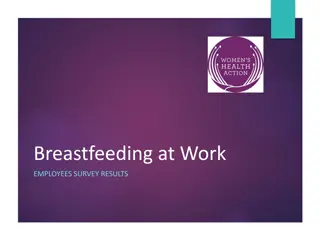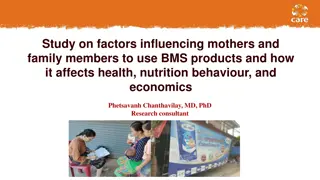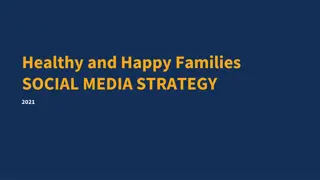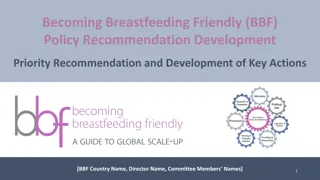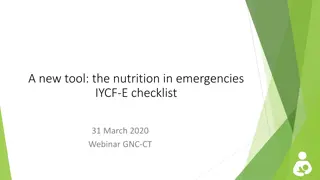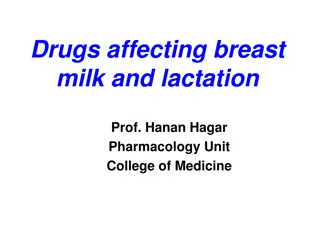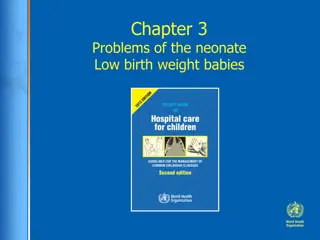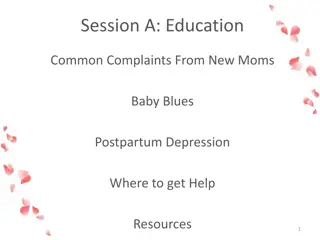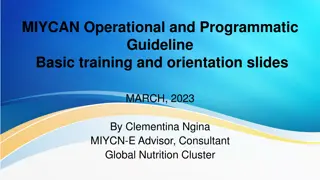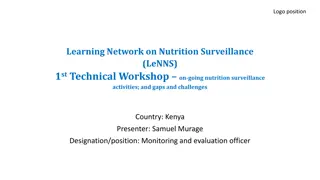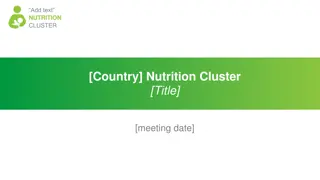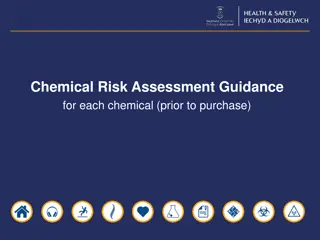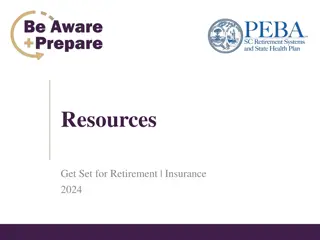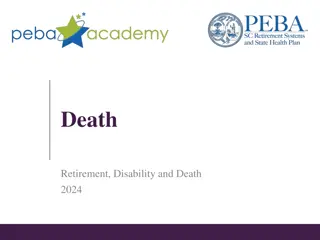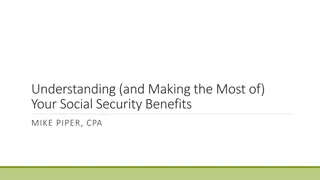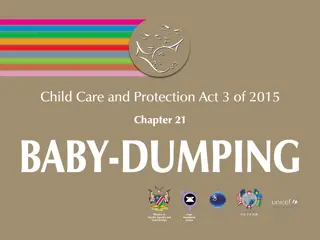The Importance of Breastfeeding: Benefits for Mom and Baby
Breastfeeding is crucial for the health and well-being of both mothers and babies. It is recommended to exclusively breastfeed for the first six months and continue with complementary foods in the following months. Breastfeeding provides numerous benefits, from antibodies in colostrum to long-term health advantages like lower risks of allergies, asthma, and obesity. It is a natural and invaluable gift that supports the bonding between mother and child while promoting optimal growth and development.
Download Presentation

Please find below an Image/Link to download the presentation.
The content on the website is provided AS IS for your information and personal use only. It may not be sold, licensed, or shared on other websites without obtaining consent from the author. Download presentation by click this link. If you encounter any issues during the download, it is possible that the publisher has removed the file from their server.
E N D
Presentation Transcript
Introduction to breastfeeding
Babies should be breastfed and/or receive expressed human milk exclusively for the first six months of life. Breastfeeding should continue with the addition of complementary foods throughout the second half of the first year. - The American Academy of Pediatrics
Your body is getting ready Darkening of the areola Growth of the breast Increased circulation
Baby is Getting Ready Sucks thumb Prefers circles to squares Sees contrast, light vs. dark Knows mother s smell
Colostrum Thick, yellowish liquid First 48-72 hours Gives baby antibodies to protect your baby from infections
Amazing Milk Your milk is made perfectly for your child Always clean Caregiver friendly stools Always the right temperature Natural tranquilizers
The First Week From colostrum to milk Baby suckling stimulates milk Milk comes in 3-4 days postpartum Breasts may leak Breasts feel full with possible engorgement Baby swallows more
Breastfeeding Benefits for Baby Less spit up, gas, diarrhea, and constipation Healthier from the start Stronger immune system Better vision Lowers the risk of Sudden Infant Death Syndrome (SIDS)
Breastfed Babies are Fit for Life Fewer allergies, eczema, and asthma Lowers the risks of leukemia, diabetes, and heart disease Less likely to become obese as adults
Breastfeeding Benefits for Mom Less postpartum bleeding Lowers the risk of anemia Increased caloric intake Produces naturally soothing hormones Lessens the risk of osteoporosis Lowers the risk of breast, ovarian, and uterine cancers Delays menstruation
Partners are Nurturing Too Take care of mom Help with the breastfeeding routine Help with household responsibilities Develop unique and special bond with baby Introduce a bottle after nursing is well established, at least 3-4 weeks
Happy Birthday Baby! Imagine the baby s birth from the baby s point of view Cold Bright Noisy Bring the baby back to mom to help the baby with transition to the outside world The less separation of mom and baby, the better
Get Off to a Good Start Right after birth baby is most alert Early and frequent skin-to-skin contact Allow the baby to: Touch the breast Taste the colostrum Attempt to latch
Benefits of Skin to Skin Allows mom to see feeding cues Increases milk production Decreases crying and provides comfort Regulates baby s heart rate, temperature, and blood sugar Increases baby/caregiver bonding
Nursery nest Pillows or boppy Water/snacks Reading material Remote and phone Nursing pads Diapering supplies Nail file Burp cloth Receiving blanket
Helpful breastfeeding clothing Nursing bra Nursing tank Cover-up
Hunger Cues Rooting, turning head toward the breast Sucking on hand or thumb Smacking lips Tongue movements Restlessness Crying
Latching Baby Important for mom s comfort Important for milk supply Use pillows to position baby Check lips and tongue position Avoid pulling on nipple Break latch when painful
A Typical Feeding Look for hunger cues Latch baby on fullest side Burp baby, offer second side Baby will nurse for 10-45 minutes Feed on demand
Milk Production Tips Supply and demand The more the baby nurses, or the more you pump, the more milk you will make Stay hydrated Supplemental or bottle feedings will decrease your milk supply, especially in the early weeks Watch the baby not the clock Go everywhere with your baby
Signs Baby is Getting Enough Baby will: Nurse 10-45 minutes per feeding Nurse 8-12 times in 24 hours Have 6-8 wet diapers and 3-4 stools in 24 hours Mom will Hear swallowing Breasts will feel softer Change a lot of diapers Have the baby weighed if there are concerns
What Can be Done if it Hurts? Home cures Lanolin Soothies Breast milk Check latch and position
Call Lactation or your Doctor if you Experience: Pain Bleeding Flu-like symptoms Fever Frustration
Nighttime Feedings Parents need sleep, too! Baby will nurse at night Utilize a co-sleeper or bassinette Nap when baby naps Feeding more during the day means feeding less at night Have partner give baby a bottle once nursing is established Establish an overnight routine utilizing both partners
Utilizing a Breast Pump Not everyone will need a pump Great if you are going back to work Several different kinds of pumps Educate yourself prior to purchase Read the manual to use the pump efficiently
Pumping Always feed your baby first and then pump There is the most milk in the morning Pump/express as many times as you would breastfeed baby while you are away from baby Breastfeed once you are with baby again Silicone milk collector
Storing Breastmilk Avoid adding freshly pumped milk to already cooled milk Freeze milk in small portions Label containers with the date and baby s name Use oldest milk first
Thawing Breastmilk Thaw breastmilk in the container it has been stored in Thaw overnight in the refrigerator or hold under/in warm water Never use a microwave or hot water Use thawed milk within 24 hours Never refreeze thawed milk
Bottle Feeding Paced bottle feeding Hold baby upright so baby has control of flow Alternate sides halfway through a feeding or with every other feeding Use a slow flow nipple to mimic the breast Burp after each feeding Watch for feeding cues Use this time to bond with baby
Medication and Foods Avoid caffeine and alcohol Eat a variety of foods to introduce the baby to new flavors Acetaminophen, Ibuprofen, and Sudafed are all safe Consult your doctor, pharmacist, or lactation consultant with questions
Common Problems in the First 6 Weeks Not nursing enough Feeding time is too short Overuse of bottles and pacifiers Poor latch Associating normal newborn behaviors with breastfeeding problems
Find Support Friends and family Lactation consultants Le Leche League Online resources
Trust your Body, Trust your Baby It can take up to six weeks to master breastfeeding Be patient with yourself, trust yourself and your baby Support is key Every feeding is a gift of love Relax
A newborn baby has only three demands. They are warmth in the arms of its mother, food from her breasts and security in the knowledge of her presence. Breastfeeding satisfies all three. -Grantly Dick-Read


